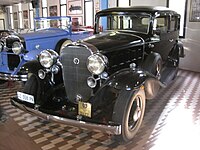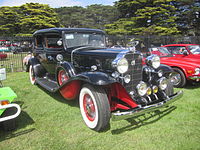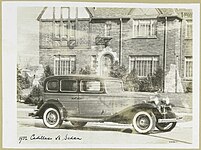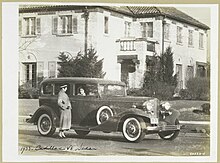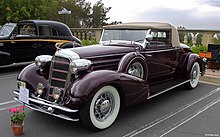
The Cadillac Eldorado is a luxury car manufactured and marketed by Cadillac from 1952 until 2002 over twelve generations.

The Buick Electra is a full-size luxury car manufactured and marketed by Buick from 1959 to 1990, over six generations. Introduced as the replacement for the Roadmaster lines, the Electra served as the flagship Buick sedan line through its entire production and was offered as a six-passenger four-door sedan with two-door sedan, two-door convertible, and five-door station wagon variants.

The Oldsmobile 98 is the full-size flagship model of Oldsmobile that was produced from 1940 until 1942, and then from 1946 to 1996. The name – reflecting a "Series 90" fitted with an 8-cylinder engine – first appeared in 1941 and was used again after American consumer automobile production resumed post-World War II. It was, as it would remain, the division's top-of-the-line model, with lesser Oldsmobiles having lower numbers such as the A-body 66 and 68, and the B-body 76 and 78. The Series 60 was retired in 1949, the same year the Oldsmobile 78 was replaced by the 88. The Oldsmobile 76 was retired after 1950. This left the two remaining number-names to carry on into the 1990s as the bread and butter of the full-size Oldsmobile lineup until the Eighty Eight-based Regency replaced the 98 in 1997.

The Pontiac Catalina is a full-size, junior series automobile produced by Pontiac from 1950 to 1981. Initially, the name was a trim line on hardtop body styles, first appearing in the 1950 Chieftain Eight and DeLuxe Eight lines. In 1959, it became a separate model as the "entry-level" full-size Pontiac.

The Chrysler Imperial, introduced in 1926, was Chrysler's top-of-the-line vehicle for much of its history. Models were produced with the Chrysler name until 1954, after which it became a standalone brand; and again from 1990 to 1993. The company positioned the cars as a prestige marque to rival Cadillac, Continental, Lincoln, Duesenberg, Pierce Arrow, Cord, and Packard. According to Antique Automobile, "The adjective 'imperial' according to Webster's Dictionary means sovereign, supreme, superior or of unusual size or excellence. The word imperial thus justly befits Chrysler's highest priced model."

The Cadillac Calais is an automobile that was the entry-level Cadillac model that was sold from 1965 to 1976. Cadillac renamed its low-priced Series 62 in 1965 as the "Calais", after the French port city of Calais that overlooks the narrowest point in the English Channel. In Greek mythology, Calais was one of two winged sons of Boreas, god of the North Wind, and Oreithyea. With the exception of no convertible model, the Calais shared the same styling and mechanics as the better-equipped, more expensive Cadillac de Ville.

The Buick Roadmaster is an automobile that was built by Buick from 1936 until 1942, from 1946 until 1958, and then again from 1991 until 1996. Roadmasters produced between 1936 and 1958 were built on Buick's longest non-limousine wheelbase and shared their basic structure with the entry-level Cadillac Series 65, the Buick Limited, and after 1940, the Oldsmobile 98. Between 1946 and 1957 the Roadmaster served as Buick's flagship.

The Cadillac Sixty Special is a name used by Cadillac to denote a special model since the 1938 Harley Earl–Bill Mitchell–designed extended wheelbase derivative of the Series 60, often referred to as the Fleetwood Sixty Special. The Sixty Special designation was reserved for some of Cadillac's most luxurious vehicles. It was offered as a four-door sedan and briefly as a four-door hardtop. This exclusivity was reflected in the introduction of the exclusive Fleetwood Sixty Special Brougham d'Elegance in 1973 and the Fleetwood Sixty Special Brougham Talisman in 1974, and it was offered as one trim package below the Series 70 limousine. The Sixty Special name was temporarily retired in 1976 but returned again in 1987 and continued through 1993.

The Cadillac Series 70 is a full-size V8-powered series of cars that were produced by Cadillac from the 1930s to the 1980s. It replaced the 1935 355E as the company's mainstream car just as the much less expensive Series 60 was introduced. The Series 72 and 67 were similar to the Series 75 but the 72 and 67 were produced on a slightly shorter and longer wheelbase respectively. The Series 72 was only produced in 1940 and the Series 67 was only produced in 1941 and 1942. For much of the postwar era, it was the top-of-the-line Cadillac, and was Cadillac's factory-built limousine offering.

The Cadillac Series 40-62 is a series of cars which was produced by Cadillac from 1940 through 1964. Originally designed to complement the entry level Series 61, it became the Cadillac Series 6200 in 1959, and remained that until it was renamed to Cadillac Calais for the 1965 model year. The Series 62 was also marketed as the Sixty-Two and the Series Sixty-Two. The Series 62 was used to introduce the Cadillac Coupe de Ville and the Cadillac Eldorado which started out as special appearance packages that were later placed into production.

The Cadillac Series 61 was Cadillac's mainstream product model range. It was priced and equipped more modestly below the limousine, GM D platform Cadillac Series 85, Cadillac Series 90, Cadillac Series 72, Cadillac Series 67, and Cadillac Fleetwood Series 75. It was upgraded to the Series 62 in 1940 only to return to production in model year 1941, replacing the cancelled LaSalle Series 50. While production was suspended from model years 1943–1945 due to World War II, it remained as the junior level product line until 1951. The size, equipment list and quality level were the most popular with buyers who wanted a prestigious luxury car that was usually driven by the owner, while the longer cars were chauffeur driven. It combined the most popular features of the previous Series 60 and Series 65 and was priced at the same level as Buick products of the time.

The Plymouth GTX is an automobile introduced as the Belvedere GTX in 1967 by the Plymouth division. It was positioned as a mid-sized upscale-trimmed performance muscle car through the 1971 model year.

The Cadillac Series 65, after the Series 60, represented Cadillac's second, and, being built on the C-body instead of the B-body, somewhat physically larger entry into the mid-priced vehicle market when it appeared in 1937. It was slightly higher in status than the LaSalle, also offered by Cadillac.

The Buick Super is a full-sized automobile produced by Buick from 1940 through the 1958 model years, with a brief hiatus from 1943 through 1945. The first generation shared the longer wheelbase with the top level Roadmaster while offering the smaller displacement engine from the Buick Special. The Super prioritized passenger comfort over engine performance. For several years, it was called the "Buick Eight" or "Super Eight" due to the engravement on the grille while all Buick's since 1931 were all installed with the Buick Straight-8 engine with varying engine displacement.

The Cadillac DeVille is the nameplate used by Cadillac over eight generations, originally used to designate a trim level of the 1949 Cadillac Series 62 and later to designate a standalone model in the brand range. The last model marketed specifically as a DeVille was the 2005 full-size sedan, at the time, Cadillac's largest model.

The Chevrolet Van or Chevy Van is a range of vans that was manufactured by General Motors from the 1964 to 1996 model years. Introduced as the successor for the rear-engine Corvair Corvan/Greenbrier, the model line also replaced the panel van configuration of the Chevrolet Suburban. The vehicle was sold both in passenger van and cargo van configurations as well as a cutaway van chassis that served as the basis for a variety of custom applications.

The Cadillac V-12 is an exclusive V-12 powered luxury car that was manufactured by Cadillac from the 1930 through the 1937. Below only the maker's top-of-the-line Cadillac V-16 line, these were powered by the Cadillac V12 engine, furnished with similar custom bodies, and built in relatively small numbers. A total of 10,903 were made in the seven model years that the automobile was built, with the majority having been constructed in its inaugural year. It was Cadillac's first, and is to date, Cadillac's only standard production V-12 automobile.
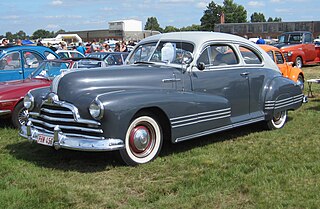
The Pontiac Streamliner is a full-size car produced under the Pontiac brand by General Motors from 1932 until 1952. A mass-produced and popular vehicle, it was a significant luxury car during the recovery from the Great Depression, and during and immediately after the Second World War.

The Jeep Wrangler YJ is the first generation of Jeep Wrangler four-wheel drive small off-road vehicles, rebadging and succeeding Jeep's CJ series, which was produced from 1944 to 1986. The first Wrangler was launched in 1986 and ran through 1995. Although the new Wrangler stood out from its CJ predecessors by its square headlights, its body was a direct evolution of the preceding CJ-7, and rode on the same wheelbase. The Wrangler featured an updated interior, offered more comfort and improved safety and handling, through a revised chassis that included a wider track and a slightly lower stance.

The Pontiac 6 was a more affordable version of its predecessor Oakland Six that was introduced in 1926, sold through Oakland Dealerships. Pontiac was the first of General Motors companion make program where brands were introduced to fill in pricing gaps that had developed between Cadillac, Buick, Oldsmobile, Oakland and Chevrolet. The original marketing approach began when GM was incorporated in 1908 was to offer a range of vehicles in various body styles based on affordable to extravagant, and the customer base would gradually trade up every few years to the next hierarchy brand. Pontiac was introduced as an affordable Oakland, followed by LaSalle for Cadillac, Marquette for Buick and Viking for Oldsmobile. Pontiac's introduction was a sales success while customers shied away from the more expensive Oakland, and once the Wall Street Crash of 1929 and the Great Depression followed, both Pontiac and Oakland were being considered for cancellation but the decision was made to keep Pontiac as the economy began to recover.

